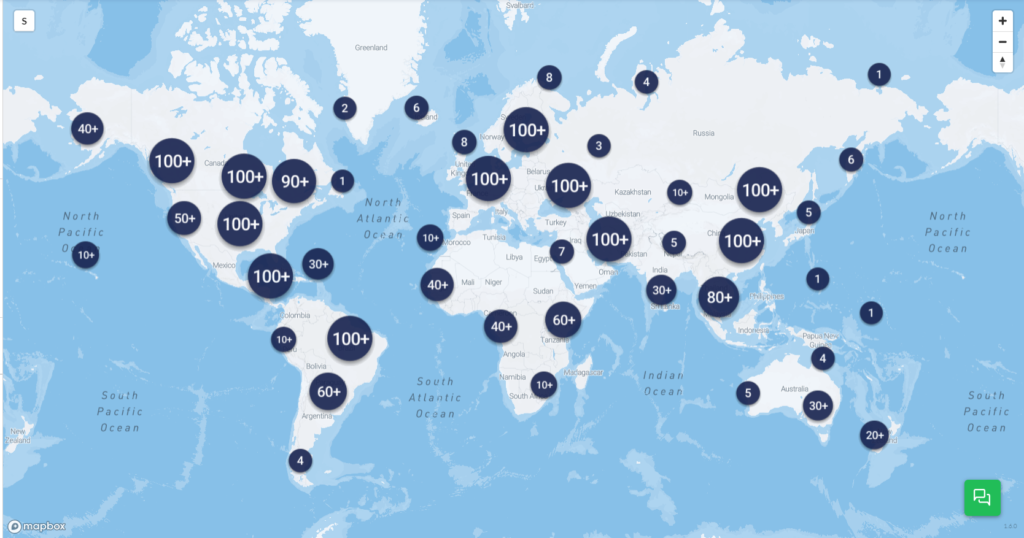Introduction: Market Segmentation
In theory, market segmentation is described as the activity of dividing a broad market, consisting of existing customers and leads, into smaller more homogenous groups that have some common characteristics.
The main purpose of market segmentation is to identify the high yield segments to approach with a unique value proposition or marketing strategy. There are many different ways to segment a market. In business-to-business, company size, turnover or regional segmentation is common while in business-to-consumer, often demographics, lifestyle or behavioural segments are used.
How Does This Work for Companies That Sell Their Products to the Tank Storage Industry?
The Global Tank Storage Industry
The global tank storage industry consists of more than 4.900 terminals with a capacity of more than 1 billion cubic meter storage space. These sites are scattered around the world, close to the high production areas and near high consumption areas.
Although, these terminal companies have different functions (e.g. strategic, logistical, import/export or trading functions), their main purpose is to balance supply and demand. Roughly spoken the concentration with the most tanks are in the regions of North America, Europe and Asia. These regions represent high consumer markets, production areas with refineries and chemical plants and three from the four trading hubs (ARA, Singapore and USGC) are located here.

Product or Service Providing Companies in The Tank Storage Industry
There are numerous companies that sell their products and services to the tank storage industry. This varies from ‘services’ such as recruitment, software, cleaning, inspection to ‘products’ such as pumps, valves, steel, domes, loading arms, pipelines, paint and much more. For all of these companies, the tank storage sector is either their main focus area or part of a larger differentiated strategy.
However, these companies are able to maximize profits when they break down this industry into segments, select one or more segments as targets, position themselves and develop a marketing strategy for each segment.
In the case of the tank storage industry there are a number of important segmentation variables identifiable that can support in choosing high yield targets.
1) Location (Geographic)
The most frequently used segmentation variable is geographic or location. An equipment supplier or service provider of the storage industry is able to segment based on location for instance region (e.g. Middle East or ARA), country (United States) or port (Antwerp). After sizing the segment, the selling party is able to approve this segment or conclude the selection is too large or too narrow. When a selection has enough ‘critical mass’ other segmentation variables can be chosen in order to make it a more acceptable group. If the geographic location is too narrow, one can opt for another neighbouring area, for instance cluster terminal operators in both The Netherlands and Belgium.
2) Tank size (Demographic)
Demographic segmentation assumes that segments with the same demographic profile show a similar purchasing pattern, interests. This will translate into similar buying preferences. Based on tank size or tank capacity, an equipment supplier can divide his segment into small sized terminal operators, medium sized terminals or large sized terminals. Larger sized terminals have more scale thus more need for equipment. Often this companies are more complex than smaller sized terminals making them more dependent on software and other automized tools.
3) Number of tanks (Demographic)
The same tactic can be applied to segmentation variable ‘number of tanks’. A selling party could divide his/her segment in terminal operators with a high number of tanks, low number of tanks and average number of tanks. Many tanks can either point to large sized companies or point to many small tanks which says something of the product that is being stored. In general, crude oil is stored in large tanks while chemicals is stored in small tanks. Dividing tank size with number of tanks will lead to average capacity per tank. When there is a high average tank size less volatile and less sophisticated products are stored, when the average tank size is small, very volatile and complex liquids are stored.
4) Tank types (Demographic)
Terminal operators use different tank types when tanks are constructed. Mild steel is mostly used for storing hydrocarbon liquids while coated and stainless steel are used to store more aggressive hydrocarbon liquids and chemicals. The main purpose of tank type is to prevent or minimize corrosion of the steel and increase economic lifecycle of the tanks. Information on tank types is valuable information for f.e. steel and manufactures. They are able to group and target specific segments in these areas.
5) Access modes (Demographic)
Access modes can be a very useful segmentation variable for equipment suppliers or service providers, who produce and sell specialized products or services to the industry. Terminals with barge and sea access could be targets for companies that sell f.e. marine loading arms. Terminals with truck and rail access could be an interesting segment for companies that produce and sell top and bottom loading arms. Terminals with pipeline access could be the main target for pipes, pumps and valves manufacturers.
6) Head-office (Demographic)
Bargaining power is determined how many terminals an operating company exploits. When a lot of terminals fall under the flag of an operating company, the bigger the bargaining power of this operating company becomes. Most of the times they have organized their sourcing and purchasing around one centralized point. Some dominant players in the game are Buckeye, Kinder Morgan, Oiltanking and Vopak.
They operate respectively 118, 101, 85 and 78 terminals. You can well envision the power of these enormous companies. However, when you manage to get on their vendor list and become a preferred supplier a lot of business can be done.
This is mostly interesting for equipment suppliers that offer the same global scale and can offer the required volumes. It might also be interesting to look at terminal operators with only one terminal as these might be open for a flexible customized approach. Bargaining power of a single terminal operator is lower than a multi-terminal owning company but could prove to be an interesting target.
7) Cargo Types (Demographic)
Storing light ends requires different tank storage specifications in comparison with storing middle distillates, heavy ends, chemicals or biofuels. For instance producers for vapor recovery units are mostly interested in terminals that store naphtha or gasoline to prevent explosive and toxic gasses to escape into open air. Heating must be used to storing products with a low viscosity or some biofuels therefore an essential segmentation criteria for companies that sell these products to terminal companies storing this product.
Under construction/expansion and planned investments (Targeting)
The number of projects that are under way or are announced says something about growth in demand pockets. If there a lot investments in a certain area or by a specific terminal operator, this offers an opportunity to grow for equipment suppliers. Greenfields and brownfields show there is money to spend by the terminal operator and they are striving for long term business continuity. Why else would they spend millions of dollars in land lease, materials, personal and more. High growth areas (or terminal operators) are preferred over stable or low growth areas (or terminal operators) as they offer a larger likelihood of acquiring goods.
Conclusion
According to a study by consultancy Bain more than 80% of C-level leaders claimed that market segmentation is essential for growing their business. Bain also concluded organizations with a market segmentation strategy in place showed better earnings than companies who did not follow a segmentation strategy.
Equipment suppliers and service providers in the tank storage industry should therefore segment their market in groups and make a well-thought assessment which segments to target. With a segment-based marketing and sales strategy their message will resonate better and will ultimately lead to better earnings.
The data for this article was gathered with the support of TankTerminals.com’s database. With only a few clicks and couple of seconds the information of the biggest market players in the various regions was obtained.
Book a Customized Demo with Jacob:
Click on the image below to book a guided tour of our platform.
He will show you all the valuable data in our platform and how it will help you grow.
Jacob van den Berge, Head of Marketing & Sales Insights Global


